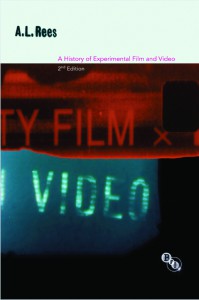A History of Experimental Film & Video - 2nd edition, by A.L. Rees (BFI Palgrave Macmillan, 2011), 208 pages, ISBN: 978-1844574360 (paperback), Price £18.99
About the Author: Dr Felicity J Colman is Reader in Screen Media in the Manchester School of Art, Department of Media, Manchester Metropolitan University. Recent publications include Deleuze and Cinema: The Film Concepts (2011) and an edited volume Film, Theory and Philosophy: The Key Thinkers (2009). E-mail: f.colman@mmu.ac.uk
 Definitions of exactly how, where, who and what constitutes ‘innovative’ or ‘experimental’ practice, leading to a recognizable ‘avant-garde’, with specific nuances and histories within different film mediums, is a complex undertaking. When published in 1999, A.L. Rees’s book provided one of the first coherent English-language volumes that presented an overview of key histories of early twentieth century European and post 1960s British artists’ films, as well as incorporating discussion of what constitutes experimental techniques and the notion of an avant-garde in film and video mediums. Rees contextualises these practices with some reference to post World War II artists’ films and experimental work made outside of these regions, including those by Maya Deren, Kenneth Anger, Andy Warhol, Stan Brakhage, Jonas Mekas, Sidney Peterson, Michael Snow, as well as some mention of extensions of experimental techniques seen in the work of filmmakers such as David Lynch. However as Rees himself points out, no account can be exhaustive and discussion tends to the trends now recognized as part of this history’s canonical avant-garde. Although limited to work largely produced in the northern hemisphere, Rees’s text is clear about the limits of its references, and the book’s popularity as a teaching resource is demonstrated by its success as the 1999 edition was reprinted seven times before this second, updated and revised edition was published in late 2011.
Definitions of exactly how, where, who and what constitutes ‘innovative’ or ‘experimental’ practice, leading to a recognizable ‘avant-garde’, with specific nuances and histories within different film mediums, is a complex undertaking. When published in 1999, A.L. Rees’s book provided one of the first coherent English-language volumes that presented an overview of key histories of early twentieth century European and post 1960s British artists’ films, as well as incorporating discussion of what constitutes experimental techniques and the notion of an avant-garde in film and video mediums. Rees contextualises these practices with some reference to post World War II artists’ films and experimental work made outside of these regions, including those by Maya Deren, Kenneth Anger, Andy Warhol, Stan Brakhage, Jonas Mekas, Sidney Peterson, Michael Snow, as well as some mention of extensions of experimental techniques seen in the work of filmmakers such as David Lynch. However as Rees himself points out, no account can be exhaustive and discussion tends to the trends now recognized as part of this history’s canonical avant-garde. Although limited to work largely produced in the northern hemisphere, Rees’s text is clear about the limits of its references, and the book’s popularity as a teaching resource is demonstrated by its success as the 1999 edition was reprinted seven times before this second, updated and revised edition was published in late 2011.
The second edition includes a new brief introduction that highlights Rees’s aims and approach to the material; a new concluding chapter that continues the discussion of late 1990s to film works made in 2010 in Britain, including an overview of how shifts in funding structures in the UK have had an impact upon the forms of work seen to be made; revised and expanded footnotes; some minor textual corrections; and still images from specific films, in monochrome and colour. The book also contains a very useful section combining endnotes with a glossary key terms. The strength of Rees’s text lies in his discussion of the various pockets of British artists, and how their practices develop. Rees’s approach is on the whole empirical and descriptive, and this style makes the book a very suitable text for undergraduate art, film and media students. Analysis is provided through brief contextualization of the film and or video medium with other plastic forms in art, comparative literary movements, with emphasis on other relative practice.
Rees’s approach is empirical and descriptive, and this makes the book very suitable for undergraduate art, film and media student
Rees notes in his introduction to the 2nd edition that his primary concern is with film and video art that is ‘experiential’ in ways that, ‘challenge the primacy and authority of illusionist imaging in cinematic space’. Different then to artists such as Tacita Dean, Bill Viola, and James Turrell (whom he names), whose work may be said to incorporate such critiques but which Rees sees as emphasizing the ‘projection devices and conditions’ of their work. Separating work according to this praxis method offers a specific aesthetic standpoint, and is a distinction that offers a rich vein for consideration and further debate about the expressive range of this art, its form, archive, exhibition and installation, and interpretation. Mindful of the artificiality of art historical lineage, Rees cautiously indicates theoretical ‘tropes’ that might be applied for further analysis of the narrative and technical material of the films, but the focus remains on description of the development of an artist’s experimental work into auteurist practice. What has really changed the territory of this field, as Rees points out, is the accessibility to these films through internet sites. For most though seeing them screened as the artist intended is preferable, and many key films still require the support of funding agencies to ensure their preservation and accessibility.
In these days of compressed curriculum, where content has to be jettisoned for the business of university, Rees provides a succinct appraisal of the core issues at stake for artists’ films, and this book offers a very useful pedagogic text for students and instructors.
Dr Felicity J Colman